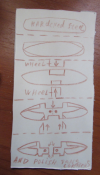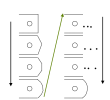Interesting topic. A couple of days ago I read about the history of the Barlow, it was said there that initially it was a cheap and reliable knife. It seems that this was before the widespread use of punching presses/dies, that is, only an emery wheel and other hand tools. I thought about it and there is an assumption that the square shank is a way to reduce time costs. As was written earlier, the cam tang requires additional time for processing. And blades with a square shank can be made 2 at a time, which is more convenient to hold in your hands, and then cut with a saw to get 2 finished blades. Last night I drew a proposed scheme

I prefer half stops, although a properly done cam is also very good!
I have several cam tang knives, here are a couple that are done right, these are great German garden knives, they close almost to the handle, and 1 is done very wrong, about halfway through the handle it snaps onto your fingers with great force, you can cut all your extensor tendons if it closes in your hand while you're working. With the half-foots, when they closed, I only got very slight cuts to the skin
I try to sharpen them all so that they cause less damage to the plant capillaries for better fusion
There was also an idea that a half-stop is just a special case of a cam tang. One of my friends is a programmer and is interested in mathematical topology, he sometimes puts forward strange thoughts, for example, that I am a donut with several holes

And I bow before the engineers of Victorinox, they definitely know what they are doing. For example, on the screwdriver in the row opposite the magnifying glass, the shank is made so that in any position of the screwdriver, the magnifying glass opens easily and does not break, it is made of plastic. There is something like the ancient French knives, but with a half stop







